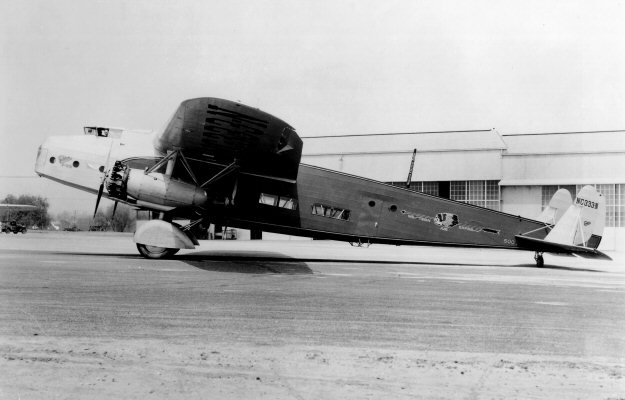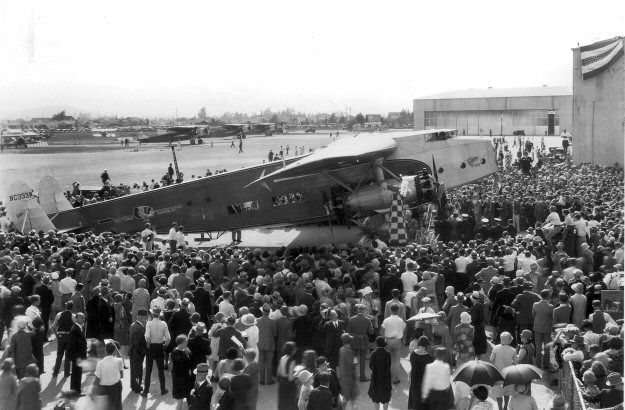Western Air
Express Fokker F-32 NC333N
(c/n 1203)

The F-32 was truly the "Jumbo" of the 1930s
era. This machine was the largest transport aircraft of its
time and seated 32 passengers in (for the day) luxury
accommodations. WAE purchased two of them
but they
proved to
be a bad investment as mechanical difficulties coupled with the
economic conditions
of the
Depression
era could not support this type of airliner. The historic image
below shows the aircraft
upon its
arrival at the new Alhambra Airport in March of 1930. WAE had
moved to this brand new
facility
with its modern administrative offices and a unique 24,000 s.f.
hexagonal hangar the previous year
from its
original base at Vail Field. Strangely, having spent over a
million dollars on the Alhambra field
they
vacated it after only a couple of years for the more strategically
placed Grand Central Air Terminal
in Glendale.
Incidentally, I managed to visit this historic field in 1956
although it gone shortly thereafter.
Following this
image is a footnote on Western's rags to riches and back to rags story
up to this point in time.

Historical
Footnote on Western Air Express:
By the time Western Air Express ordered the
F-32 it had grown (mainly through acquisition) to be a very
large carrier
indeed. It had purchased West Coast Air
Transport in 1929 (WCAT was a subsidiary of
Union
Airways at the time) which gave it rights for the
San Francisco to Seattle route. It had already (in
1927) been
granted CAM 12 from Cheyenne through Denver to Pueblo. In
1929 WAE purchased
Mid-Continent Air Express and with a route from Denver to El Paso and a
fleet of Fokker Super
Universals. 1930 saw the company acquire Standard Air Lines which had a
route from Los Angeles to
El Paso
(later extended to Dallas). Finally, it had been
granted rights for service as far east as Kansas
City.
Its empire,
then, covered 11 Western states and some 40 cities. Up to that
time it was, in fact, one of the
"Big Five"
(the others being American, Eastern, United and TAT). A powerful
diplomatic figure at that time
was Walter
Folger Brown, the Post-Master General. He could (in fact did)
reshape the airline map pretty
much the way
he wanted it (due to the all important air mail subsidies he held in
his hand) and, being from the
so called
"eastern establishment" was not endeared to upstart western companies
such as WAE.. Trans-
continental Air Transport (TAT), which had recently purchased Maddux
Air Lines providing service up and
down the
West Coast (L.A. to San Francisco and beyond), was losing money .
Brown's plan was that the
all
important (central) transcontinental route should awarded to one
company (in the name of economy and
efficiency). Unfortunately that plan didn't include WAE, but
leaned toward TAT, despite fact that WAE was
profitable and TAT was not. He insisted, therefore, that before any contract was awarded, the two
lines should
amalgamate. Under pressure, therefore, WAE agreed to merge with TAT,
the resultant line being named Trans-
continental & Western Air, later of course to become TWA - Trans
World Airlines. An autonomous WAE was
left with
their original CAM 4 from Los Angeles to Salt Lake City, and the
stand-alone Cheyenne to Pueblo
route in the
Rockies. They had been forced to sell their west coast operation
due to the increased competition
from
Maddux and the fact that the depression was on, and few were
flying. They were, in other words, right
back
where they stared in 1926. In desperation
Western turned to General Motors for infusions of cash and
early in
1933 WAE became part of North American Aviation of which General Motors
was the holding corp-
oration. Then, in 1934 the whole air mail picture changed
when the government rescinded all the existing
air mail
contracts and the U.S Army was charged with flying the
mails. This saga will be continued on the
page for
the General Air Lines DC-2.

